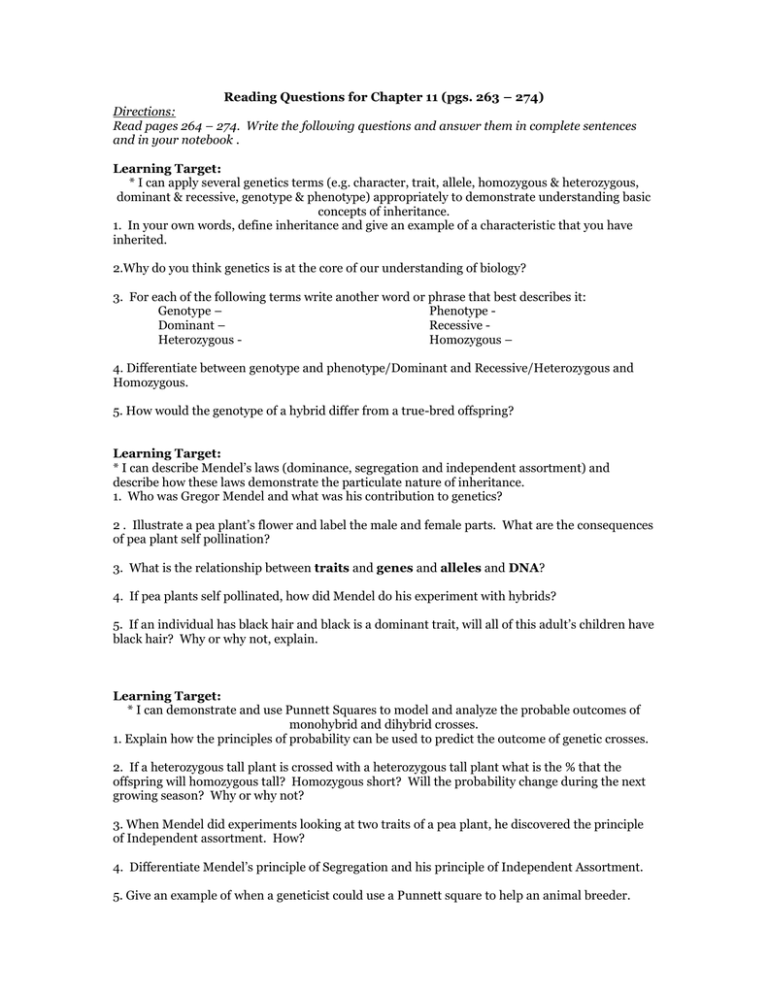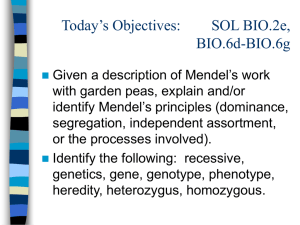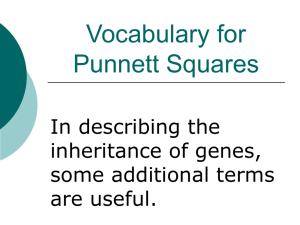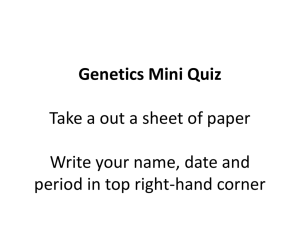Reading Questions for Chapter 11 (pgs. 263 – 274) Directions
advertisement

Reading Questions for Chapter 11 (pgs. 263 – 274) Directions: Read pages 264 – 274. Write the following questions and answer them in complete sentences and in your notebook . Learning Target: * I can apply several genetics terms (e.g. character, trait, allele, homozygous & heterozygous, dominant & recessive, genotype & phenotype) appropriately to demonstrate understanding basic concepts of inheritance. 1. In your own words, define inheritance and give an example of a characteristic that you have inherited. 2.Why do you think genetics is at the core of our understanding of biology? 3. For each of the following terms write another word or phrase that best describes it: Genotype – Phenotype Dominant – Recessive Heterozygous Homozygous – 4. Differentiate between genotype and phenotype/Dominant and Recessive/Heterozygous and Homozygous. 5. How would the genotype of a hybrid differ from a true-bred offspring? Learning Target: * I can describe Mendel’s laws (dominance, segregation and independent assortment) and describe how these laws demonstrate the particulate nature of inheritance. 1. Who was Gregor Mendel and what was his contribution to genetics? 2 . Illustrate a pea plant’s flower and label the male and female parts. What are the consequences of pea plant self pollination? 3. What is the relationship between traits and genes and alleles and DNA? 4. If pea plants self pollinated, how did Mendel do his experiment with hybrids? 5. If an individual has black hair and black is a dominant trait, will all of this adult’s children have black hair? Why or why not, explain. Learning Target: * I can demonstrate and use Punnett Squares to model and analyze the probable outcomes of monohybrid and dihybrid crosses. 1. Explain how the principles of probability can be used to predict the outcome of genetic crosses. 2. If a heterozygous tall plant is crossed with a heterozygous tall plant what is the % that the offspring will homozygous tall? Homozygous short? Will the probability change during the next growing season? Why or why not? 3. When Mendel did experiments looking at two traits of a pea plant, he discovered the principle of Independent assortment. How? 4. Differentiate Mendel’s principle of Segregation and his principle of Independent Assortment. 5. Give an example of when a geneticist could use a Punnett square to help an animal breeder. Learning Target: * I can recognize and describe alternate patterns of inheritance other than “Simple Dominance”, i.e. co-dominance, incomplete dominance, multiple alleles, polygenic inheritance, etc. 1. Give one reason why Mendel was lucky when he chose his ‘traits’ to study? 2. Differentiate between Incomplete Dominance and Codominance? 3. Can an individual have more than two alleles? Explain. 4. If an individual’s genotype is different from their phenotype, what are some of the possible explanations of why? Give at least two possible explanations. 5. Give an example of when the environment affects the phenotype of an organism.










